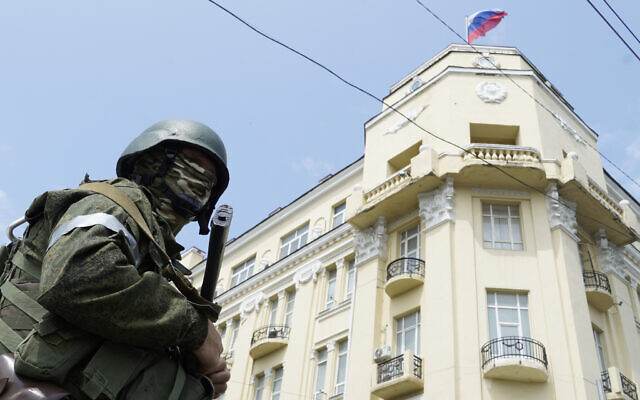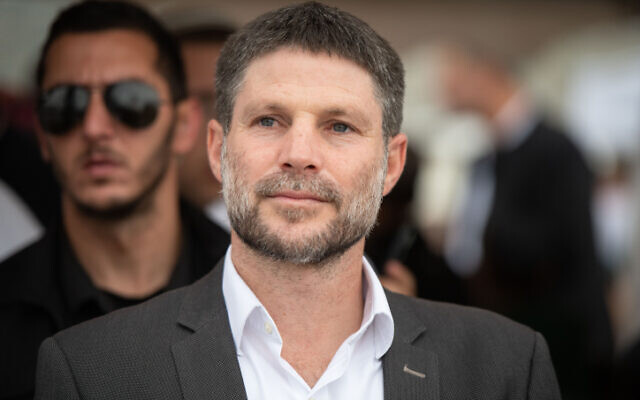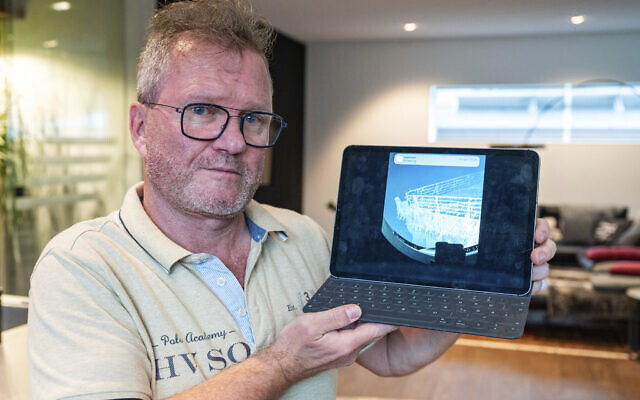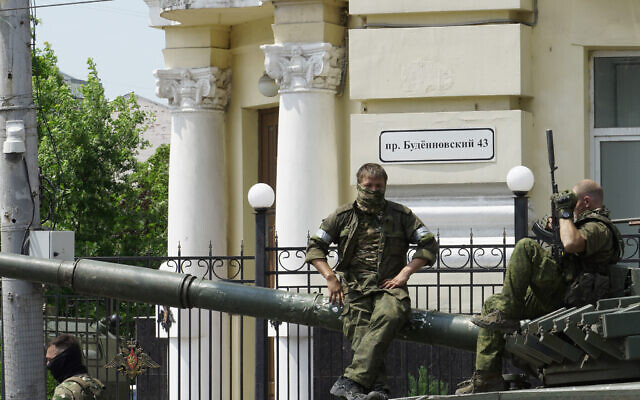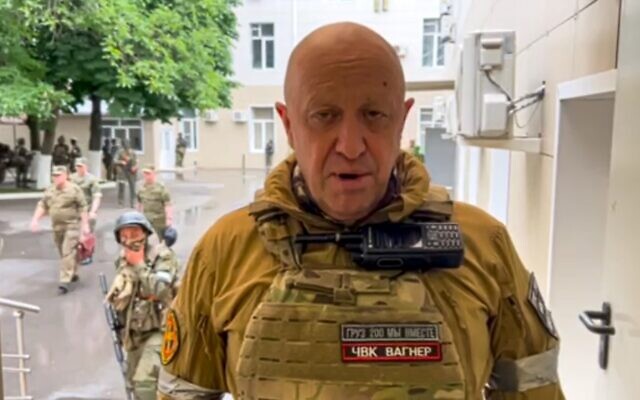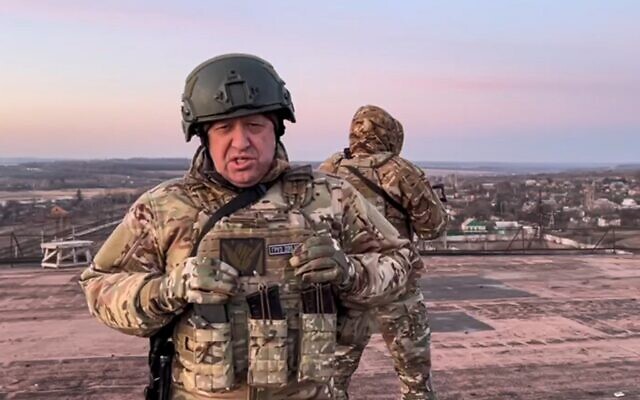London’s Imperial War Museum brings the Holocaust into the light for all to see
Unlike other memorials, the recently opened permanent exhibit is unusually well-lit, giving the very human perpetrators of the genocide of Europe’s Jews no shadows in which to hide
 James Bulgin, content leader of the new Holocaust and Second World War galleries at the Imperial War Museum in London, October 11, 2021. (Courtesy IWM)
James Bulgin, content leader of the new Holocaust and Second World War galleries at the Imperial War Museum in London, October 11, 2021. (Courtesy IWM)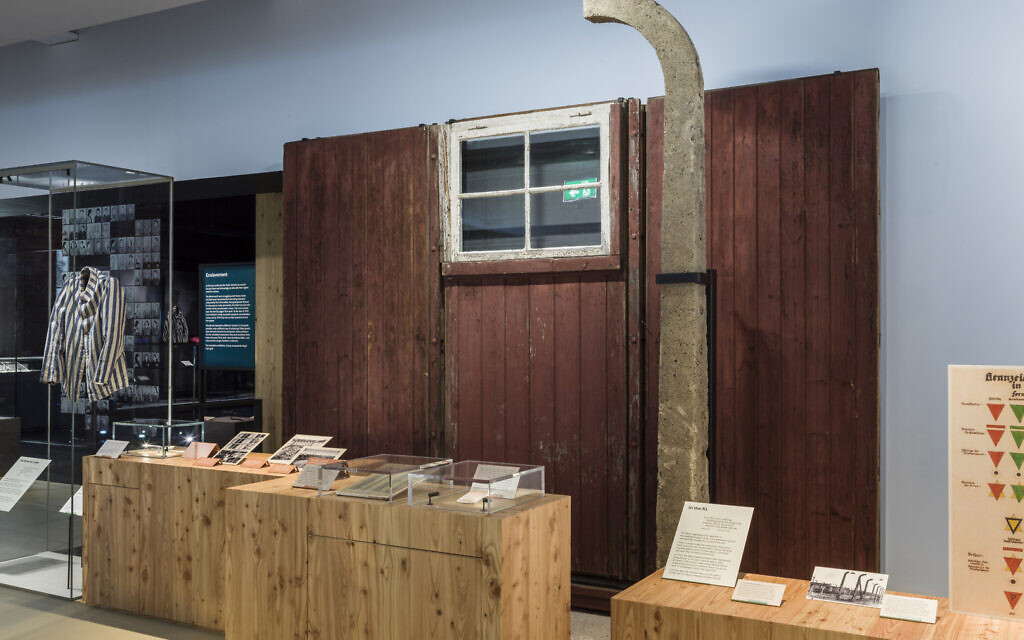 A view of the new Holocaust gallery at London's Imperial War Museum, September 30, 2021. (Courtesy of the IWM)
A view of the new Holocaust gallery at London's Imperial War Museum, September 30, 2021. (Courtesy of the IWM) Preservation technician Emily Thomas cleans a V1 Flying Bomb, pictured in the intersection between the Holocaust Gallery and the Second World War Gallery below, at the Imperial War Museum London, September 30, 2021. (Courtesy of the IWM)
Preservation technician Emily Thomas cleans a V1 Flying Bomb, pictured in the intersection between the Holocaust Gallery and the Second World War Gallery below, at the Imperial War Museum London, September 30, 2021. (Courtesy of the IWM)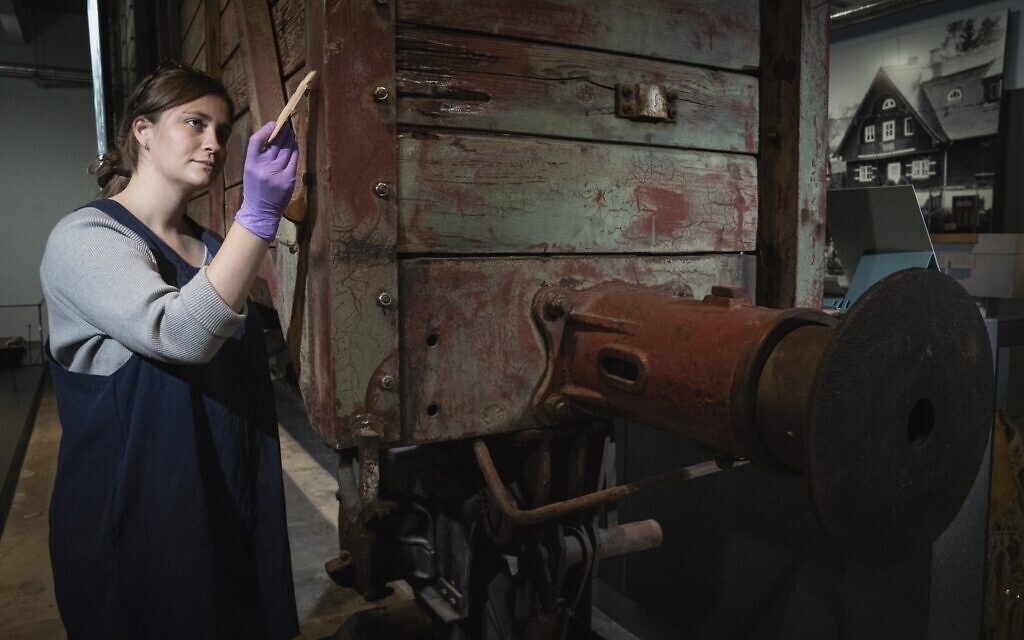 Preservation technician Emily Thomas cleans a rail wagon of the type used to transport victims to death camps at the Holocaust Gallery at the Imperial War Museum in London, September 30, 2021. (Courtesy of the Imperial War Museum)
Preservation technician Emily Thomas cleans a rail wagon of the type used to transport victims to death camps at the Holocaust Gallery at the Imperial War Museum in London, September 30, 2021. (Courtesy of the Imperial War Museum)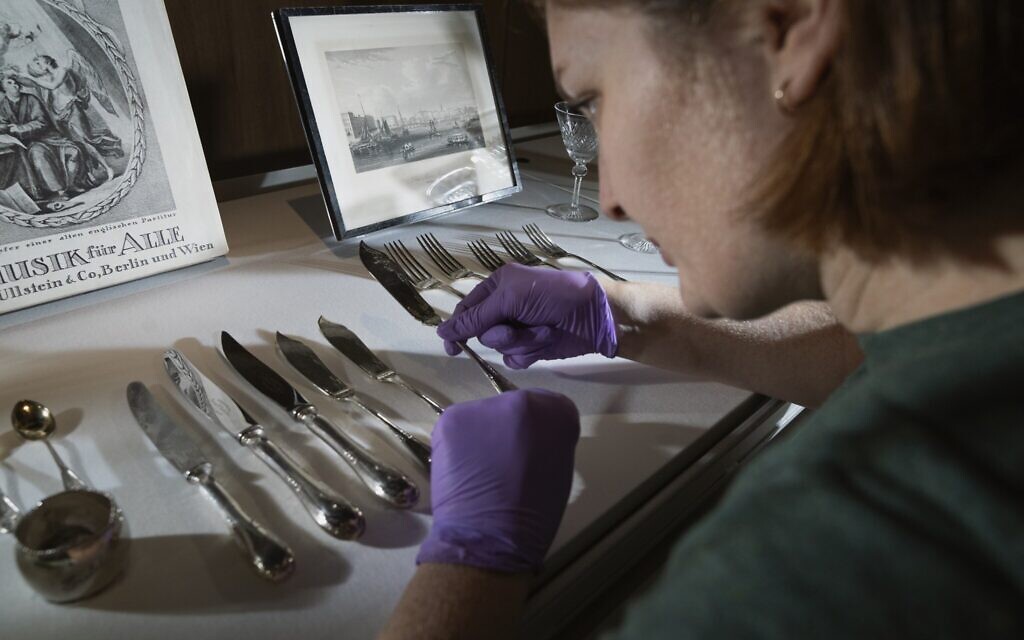 Senior conservator Jenna Taylor installs a fish knife belonging to Mr. and Mrs. Schindler in the Holocaust Gallery at London's Imperial War Museum, September 30, 2021. (Courtesy of the IWM)
Senior conservator Jenna Taylor installs a fish knife belonging to Mr. and Mrs. Schindler in the Holocaust Gallery at London's Imperial War Museum, September 30, 2021. (Courtesy of the IWM)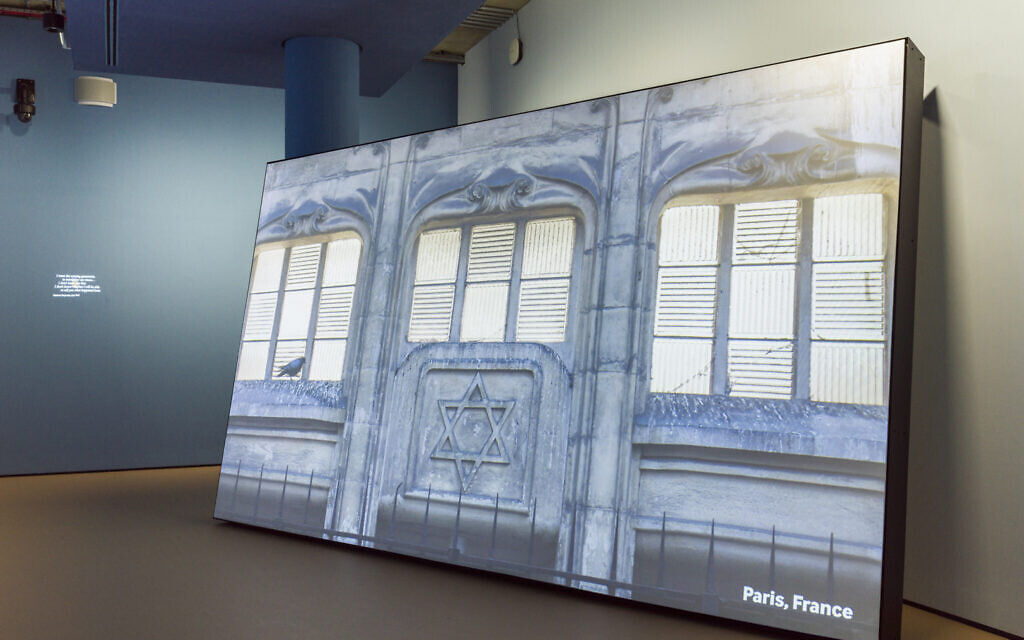 A view of the new Holocaust gallery at London's Imperial War Museum, September 30, 2021. (Courtesy of the IWM)
A view of the new Holocaust gallery at London's Imperial War Museum, September 30, 2021. (Courtesy of the IWM)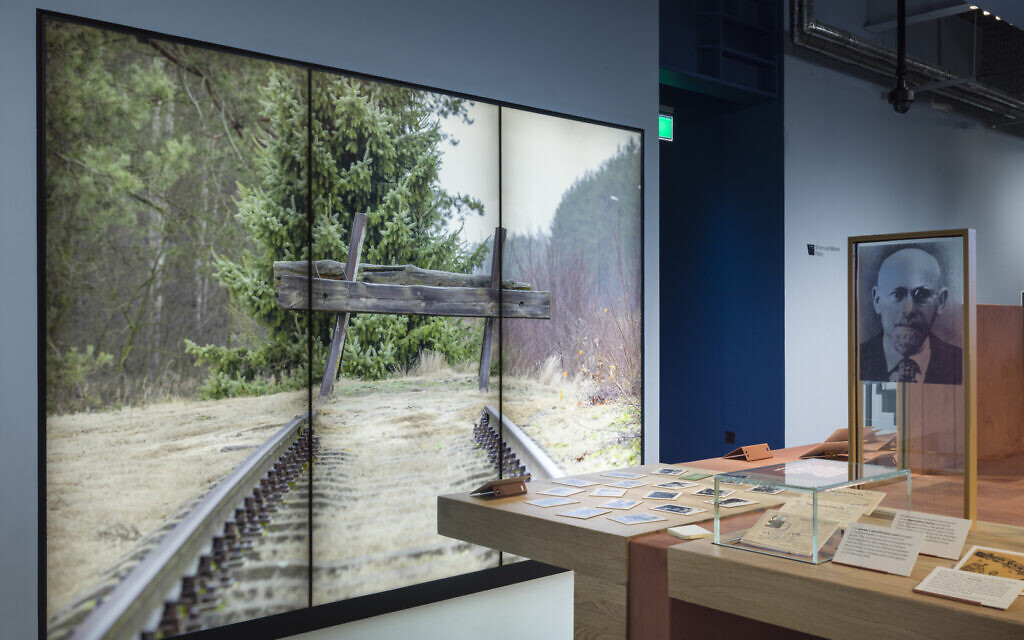 A view of the new Holocaust gallery at London's Imperial War Museum, September 30, 2021. (Courtesy of the IWM)
A view of the new Holocaust gallery at London's Imperial War Museum, September 30, 2021. (Courtesy of the IWM)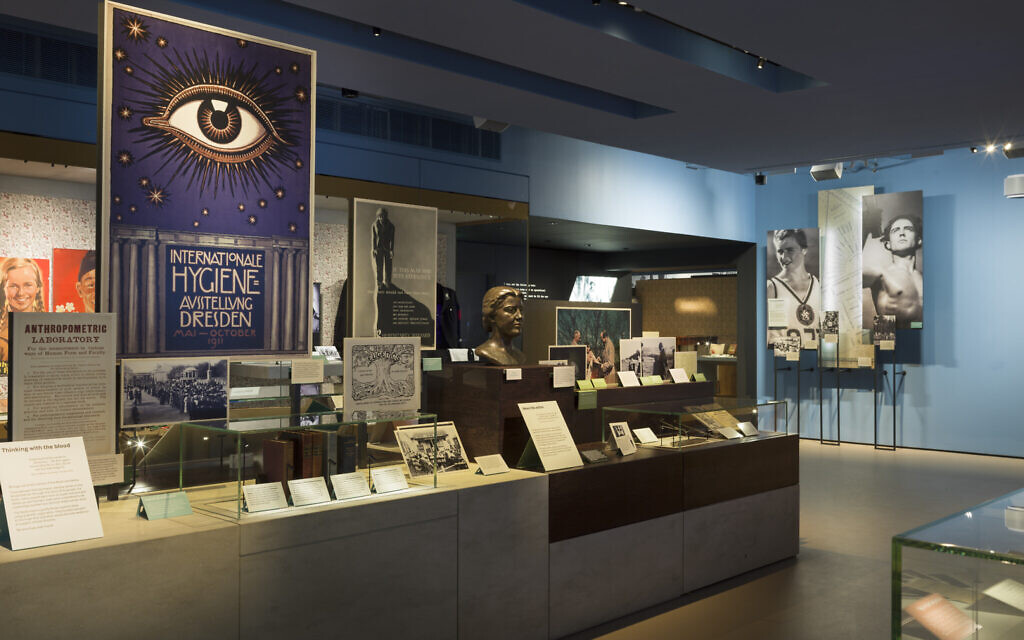 A view of the new Holocaust gallery at London's Imperial War Museum, September 30, 2021. (Courtesy of the IWM)
A view of the new Holocaust gallery at London's Imperial War Museum, September 30, 2021. (Courtesy of the IWM)
LONDON — There is a ritual that visitors often go through as they enter an exhibition on the Holocaust. They hush to a mournful silence. Their pace slows to a pilgrim’s shuffle. Their expression becomes slightly awed as they see the unthinkable and begin to wrestle with the evidence of human depravity.
These reactions are natural, conditioned by the design concepts that have understandably dominated the museums and memorials dedicated to Europe’s murdered Jews: darkness, shadows, sepia.
The Imperial War Museum in London has tried something new. By bringing the story of the Holocaust into brightly lit rooms, it has tried to illuminate and re-examine elements of the Holocaust narrative that are sometimes “misunderstood.”
“The big problem with dark spaces and Holocaust museums,” says James Bulgin, the Holocaust scholar who has curated the Holocaust Gallery from conception to completion, “is that as soon as you walk into a dark space it feels as if the narrative is leading inexorably in one direction, which was not the case.”
“It suggests that the only appropriate response is silence,” he says. “The subject is of course overwhelmingly tragic, but you want people to feel empowered to ask questions and to develop their understanding, and this is done through inquiry.”
“You also tacitly suggest that these things happened in the shadows, or in unseen dark spaces, and not in the world in which we all live,” he adds. “It pushes it into the distant past.”

The museum opened two new permanent galleries — one on the Holocaust, the other on World War II more generally — to the public on October 20, after a years-long, £30.7 million ($41.2 million) renovation project that replaced the existing Holocaust exhibit, which opened in 2000.
On November 10, the Duchess of Cambridge formally opened both, as well as a temporary photo exhibition looking at Holocaust survivors and their families that will be open until early January.
Together, the new galleries occupy two floors and span 3,000 square meters (33,000 square feet). The Holocaust Gallery alone has some 2,000 photos, posters, and artifacts, including a section of concentration camp barracks from Velten — a subcamp of Ravensbruck and Sachsenhausen — believed to be the last remaining part of the camp.

Bulgin came late to Holocaust studies. He cut his teeth in theater production on London’s West End, and his professional background is immediately perceptible in the use of space and design choices that make the gallery both cutting-edge and tactful.
“It is about conceiving of space and tone,” Bulgin says. “We will never know what these people experienced, but we can readily understand the environment in which it occurred.”
As visitors meander through a series of interlocking rooms, large video screens beam contemporary images and sounds from the sites where millions were murdered.
“We use contemporary footage of environments as they are today, not to try and recreate them, but to say, forests and birdsong — these are complex sensory feelings through which we experience reality,” Bulgin explains. “The little moment of connection between the two is important.”

The design choices at the Imperial War Museum can be simultaneously bold and imperceptible.
Photos tend to be placed at eye level so that “people are looking you in the eye throughout the gallery,” says Bulgin. Sepia, “which speaks about the passage of time rather the authenticity of the image as it existed,” has been banished, he says.
Objects are placed where they would be in the real world and books positioned as if they were being handed to you. “There is a logic here,” Bulgin says.
These small choices feed into the exhibition’s central objective: reflecting recent advances in Holocaust research and correcting misunderstandings in how the Holocaust is remembered in Britain.

“I was concerned that the Holocaust was being misunderstood and was being framed in ways that were not always particularly historically accurate, but also didn’t treat the Jewish individuals and communities within the narrative appropriately,” Bulgin says.
“Every major Holocaust museum has framed this whole narrative as one of industrialized genocide — that it was based around Auschwitz and nowhere else. For me, the idea that it is this mechanized process is really misleading,” he says. “In many ways, it is very dirty and basic. Brutal, bloody and barbaric.”
Ghettoes and the massacres of Eastern Europe’s “Holocaust by Bullets” find themselves placed at the center of the Imperial War Museum narrative, alongside the more commonly known and horrific images of the death camps.

Bulgin has also sought to introduce into the public consciousness a more serious appreciation of the Holocaust’s perpetrators and their motives. Bulgin was concerned that “a lot of our visitors had a conditioned image of the perpetrator that was very much defined by the likes of Amon Göth in ‘Schindler’s List.’”
“What is far more terrifying,” he says, “is that that it was relatively normal people doing it, and somehow because of the nervousness about humanizing perpetrators they have been pushed to the margins of the narrative.”
Negotiating how to present their atrocities has been carefully considered. Photos have been kept at their original size. Black borders indicate when they were taken by Nazi photographers.
British newspaper records and the level of contemporary knowledge about the Holocaust in Britain are also introduced as a means of pushing back against a perception that the scale of the Holocaust was not fully understood until 1945.

Britain’s Jewish establishment has given the exhibition near-universal praise.
“It is not Auschwitz-centric. It looks at the Holocaust holistically,” says Ben Fuller, an educator at the Holocaust Educational Trust. “In education, we say try and broaden out from Auschwitz-centric models of learning, and that is what the exhibition has done — in fact, it has gone beyond that.”
There was a worry that the Holocaust narrative, housed within a British military museum, would move quickly towards the story’s horrific climax.
However, as visitors enter, they are introduced to hundreds of flickering images and an introduction to Jews in prewar Europe. Dutch Jews are seen giggling on a North Sea beach. Greek Jews stand bored outside a synagogue. Romanian Jews enjoy coffee in a Bucharest café. Introducing British visitors to the full spectrum and geographic breadth of Jewish life in prewar Europe plays an important role in the exhibition, which also includes a section on the Holocaust in Hungary.

“Where we start talking in Holocaust education is prewar Jewish life and understanding who the Jews of Europe were before the Holocaust,” says Fuller. “That’s what they’ve done with this exhibition. They’ve humanized and placed the focus on the people who are the victims as people first rather than seeing them purely through a spectrum of their victimhood.”
Simon Bentley, the chairman of Yad Vashem UK, the British arm of Israel’s Holocaust memorial and museum, says that the Imperial War Museum’s effort has been “sensational.”
“It is the sort of place that you go and visit, knowing that you’re going to come back many times because if you are going to do it justice it requires many visits,” Bentley says.
“It is hugely worthwhile. The quality is incredibly high — the number of artifacts and objects to be viewed, the manner of display, the extent of light versus the opposite that is more usual,” he says.

Despite the praise, some within the Jewish community feel that the Imperial War Museum’s approach may have been too limited.
Ivor Perl, a Hungarian Holocaust survivor who survived Auschwitz, Dachau’s subcamps and a death march before being liberated in April 1945, says that while “they’ve done it very tastefully and tactfully” the “horror of the whole story was so enormous that to cover it with one canvas is very hard.”
Perl, who is included in the recorded testimonies at the end of the exhibition, adds that “the horror was so enormous that one could never properly do it justice.”
Active in Holocaust education in Britain, Perl worries that the effort to tell the broader narrative has been at the expense of the true horror of the Holocaust. He survived the Holocaust along with his brother, but they lost their parents and seven brothers and sisters.
“Will it be enough to pass on the information to future generations? It remains to be seen. I personally feel that a couple more little things about the gas chambers or the camps themselves might have enhanced it,” he says.
“It is a nice and hygienic little thing. It is nice and neat. You can go and have a coffee and tea afterward,” he says. “But it is so difficult. The enormity of it — when can you say that you have done enough and included everything and anything?”
There's no paywall on The Times of Israel, but the journalism we do is costly. As an independent news organization, we are in no way influenced by political or business interests. We rely on readers like you to support our fact-based coverage of Israel and the Jewish world. If you appreciate the integrity of this type of journalism, please join the ToI Community.

We’re really pleased that you’ve read X Times of Israel articles in the past month.
That’s why we started the Times of Israel eleven years ago - to provide discerning readers like you with must-read coverage of Israel and the Jewish world.
So now we have a request. Unlike other news outlets, we haven’t put up a paywall. But as the journalism we do is costly, we invite readers for whom The Times of Israel has become important to help support our work by joining The Times of Israel Community.
For as little as $6 a month you can help support our quality journalism while enjoying The Times of Israel AD-FREE, as well as accessing exclusive content available only to Times of Israel Community members.
Thank you,
David Horovitz, Founding Editor of The Times of Israel

